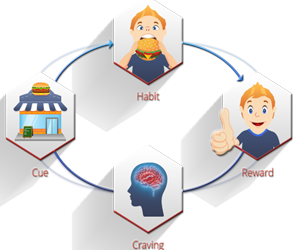
8. Adopt productive work habits
Habits are automated non-conscious behaviors which are hard-wired into the deep structures of our brain.
By deliberately and consistently practicing new behaviors, these brain structures can learn and habitualize new behaviors and skills.
The Habit Loop illustrates the process our brain uses to execute our habitual behaviors.
First there is a cue which triggers the behavior. The cue can be an external signal such as a sight or a sound, it can be an internal hormonal change such as stress or fear, or it can be a thought arising in our brain’s pre-frontal cortex.
The cue triggers the brain to access its “memory bank” which associates the cue with the behavior linked to it. The “memory bank” also stores the detailed steps comprising the behavior.
The brain then gives the command to execute the behavior.
As we complete the behavior, our brain experiences the reward associated with that behavior. The reward could be a pleasure we experience upon completing a task or achieving a goal, or it could be the avoidance of discomfort or even pain.
As we experience the pleasure or avoid the pain, our brain reinforces the memory of the behavior and the cue associated with it, and in so doing it closes the habit loop.
Adopting new productive work habits
Below are some the steps you can take to habitualize new productive work habits.
1. First define the new behavior you want to habitualize.
2. Then define the cue that will remind you to execute the behavior. The cue can be a yellow sticky note on your desktop, a reminder on your calendar, or a sign on your office wall.
3. Last define your reward for executing the behavior. The reward should be something that will motivate you to execute the behavior time and time again. It could be a physical reward you give yourself, or it could be a sense of accomplishment you develop when you complete a difficult task.
4. Now you should deliberately and persistently practice of the new behavior, day after day after day, until it becomes hard-wired into your brain’s automatic routines memory structures.
Browse other modules of the
Leadership Mastery Program by clicking on the icons!
The modules below are included in the programs for organizations and individuals
The modules below are included in the Leadership Program for organizations only.







